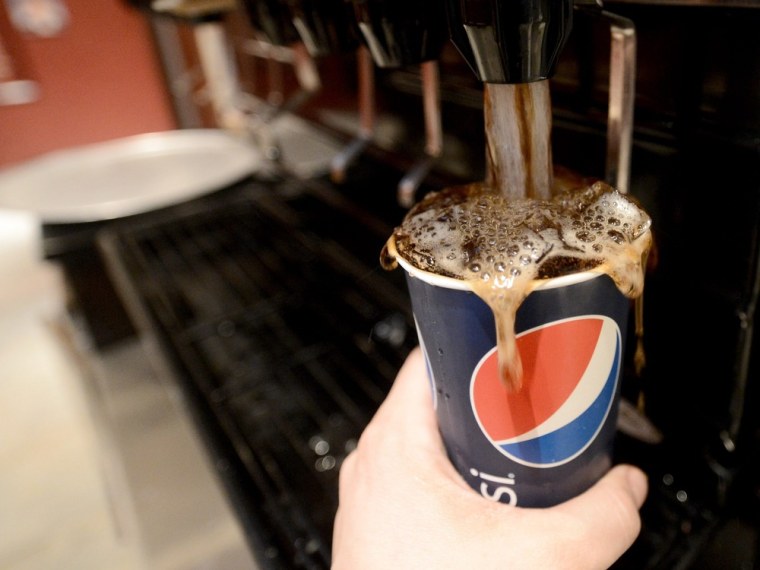A court may have ruled against New York’s supersized soda ban, but many prominent nutrition experts applaud any effort to limit how many sugary drinks Americans gulp down.
“There is really very clear evidence now that soft drinks are related to weight gain and obesity and, most certainly, diabetes,” says Dr. Walter Willett, a nutrition expert at the Harvard School of Public Health.
“We are in the midst of an epidemic of diabetes and obesity. The evidence is very clear that soda consumption has a role in the epidemic,” Willett added in a telephone interview.
“The evidence of harm for soda is longer than for anything else that we normally consume,” Willett says. “And there’s absolutely no benefit. Most foods, even if they are not the healthiest foods, have some nutritional value. Here it is all harm, no nutritional value. And the amounts being consumed are massive.”
The American Heart Association says Americans take in an average of 22 teaspoons of added sugar a day -- about 355 calories’ worth. It can have not just the obvious results, like obesity and diabetes, but also indirect harms: People who eat more sugar are also more likely to develop high blood pressure and other heart risks.
With two-thirds of Americans overweight or obese, it’s clear there is a problem. And a new study out Tuesday found that the more sugar-sweetened drinks that kids consumed, the more calories they got from other sources, too. In other words, kids who drink sugary beverages also eat other foods high in calories, the team at the University of North Carolina found.
"This is concerning because many foods that are associated with higher sugar-sweetened beverage consumption (e.g., pizza, cakes/cookies/pies, fried potatoes, and sweets) are also top sources of solid fats and added sugars; components of the diet that the 2010 Dietary Guidelines recommends Americans should limit," said nutritionist Kevin Mathias, who led the study, published in the American Journal of Preventive Medicine.
There’s no doubt Americans like to guzzle sugary drinks -- not just sodas, but sports drinks, energy drinks and fruit juices with sugar added. Beverage Digest estimates that Americans each drink 714 eight-ounce servings of carbonated soft drinks in a year -- that’s close to two a day.
Several studies have shown that the rate of type-2 diabetes has soared at just the same rate as intake of high-fructose corn syrup -- the favored sweetener in many soft drinks -- has risen. Soft drinks such as Coca-Cola were sold in 6.5-ounce bottles in the 1920s. Now the 12-ounce can is standard but fountain drinks are sold in sizes up to 64 ounces -- or the equivalent of eight of these cans of soda. One 64-ounce drink carries more than 800 calories.
All these giant servings send a message to people that it’s not only OK, but desirable to pig out, says nutritionist Deborah Kennedy, CEO of Build Healthy Kids and a co-author of “Beat Sugar Addiction Now! For Kids”
“Kids are eating their weight in sugar every year,” Kennedy told NBC News. “And sodas, energy drinks and sports drinks are the No. 1 source of sugar in kids’ diets. The message we are sending is ‘Jump right in’. What it says when these drinks are available is ‘Party time’.”
New York mayor Michael Bloomberg has said he’ll appeal the judge’s ruling, which State Supreme Court Justice Milton Tingling Jr. called “arbitrary and capricious.”
The city’s ban had applied to “sugary beverages” larger than 16 ounces. “Sugary” is defined as a sweetened drink with more than 25 calories in eight ounces. Convenience stores, supermarkets and vending machine operators were exempted.
Willett says the ban was the right and proper thing to do. “It is the role of a health department to protect the public from these hazards,” he said.
Many experts would like to see much more regulation than this. Willett believes people should not be able to buy sodas with food stamps. “We published a paper recently showing the average adult on the (food stamp) program is consuming nearly three servings of sugar-sweetened beverages a day,” he said.
When he was still New York City's health commissioner, Dr. Thomas Frieden, now director of the Centers for Disease Control and Prevention, advocated for an extra tax on sugary sodas. He and Yale University’s Dr. Kelly Brownell wrote a 2009 commentary in the New England Journal of Medicine that called sugar-sweetened drinks the single largest cause of the U.S. obesity epidemic and argued that a 1 cent per-ounce tax would lower consumption by 10 percent.
The Center for Science in the Public Interest calls soft drinks “liquid candy” and wants rules that would label them the way cigarettes are labeled now -- with health warnings. "Parents and health officials need to recognize soft drinks for what they are -- liquid candy -- and do everything they can to return those beverages to their former role as an occasional treat," the group says.
Kennedy agrees.
“Kids know that too much sugar isn’t good for them,” she said. “But they don’t have the support in the community to help them make that healthy decision.’
Kennedy and Willett both noted that the beverage industry is fighting back hard against efforts to regulate soft drinks, both by lobbying lawmakers and with high-volume, expensive advertising.
“The ads suggest that drinking soda will make you congenial. You’ll be more athletic, while the real image should be losing limbs, losing vision and other images of diabetes,” Willett said.
“One of the newer things that soda companies are doing is they are putting vitamins in the soda, which to me is atrocious because it sends the message that it is a healthy drink,” Kennedy said.
Want to know how much sugar you’re getting in a drink? Harvard has a chart online here.
Related links:
